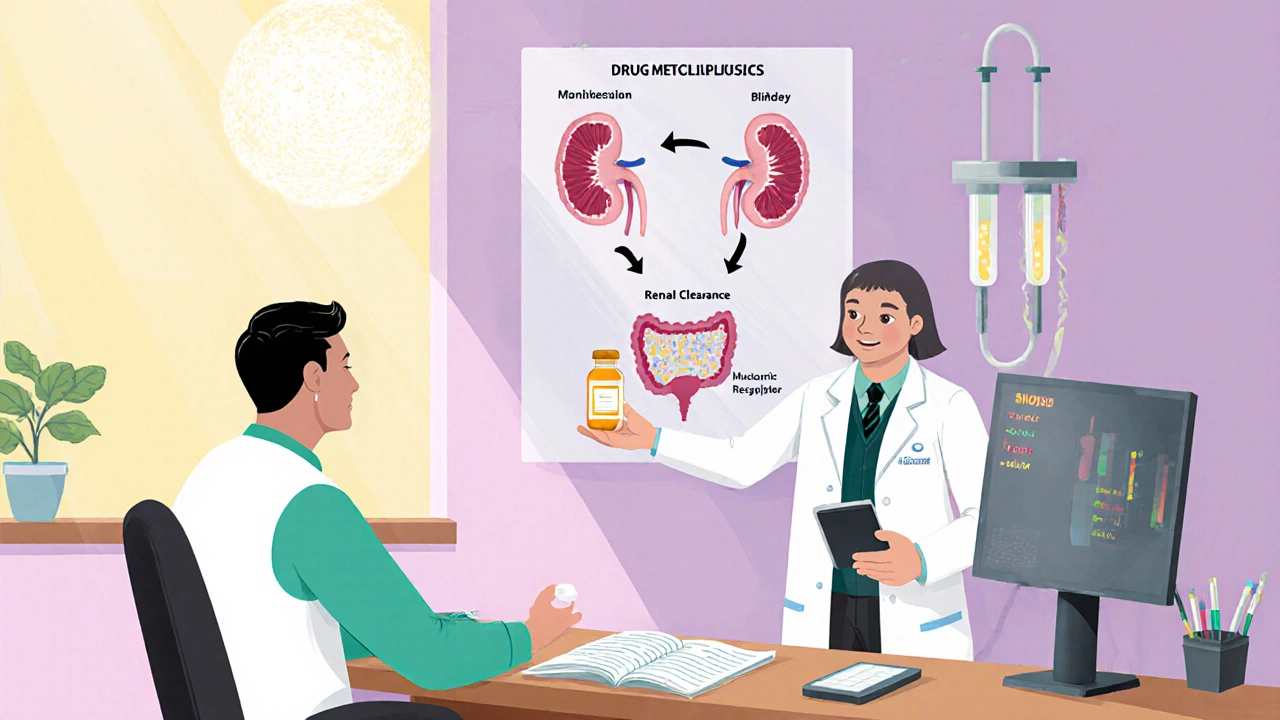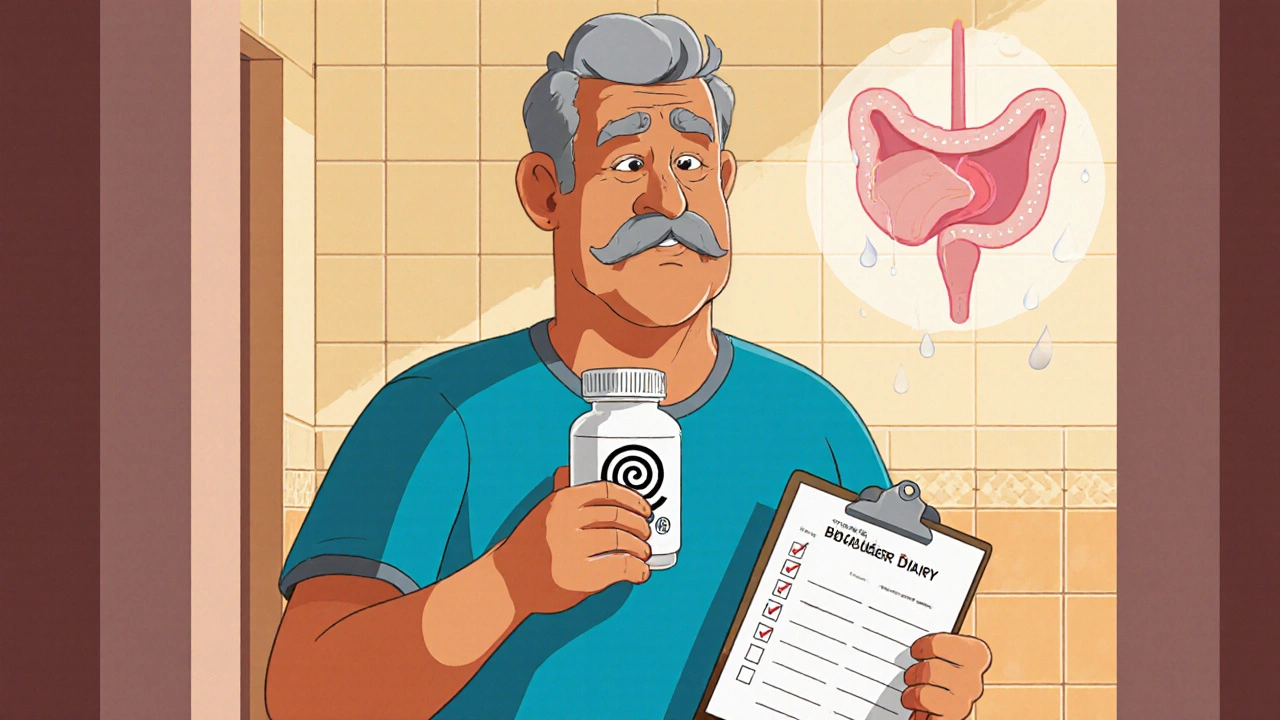OAB Treatment Failure Assessment Tool
Step 1: Assess Treatment Response
Step 2: Check Modifiable Factors
Treatment Failure Assessment
Recommended Action Plan
Key Considerations: Check renal function, review medication interactions, and ensure proper adherence before considering treatment changes.
Quick Takeaways
- Anticholinergic resistance to trospium is real and often linked to dose, metabolism, or disease progression.
- Confirm true treatment failure with symptom diaries, bladder training logs, and, if needed, urodynamic testing.
- Switching to a beta‑3 agonist like mirabegron, or combining low‑dose anticholinergics, can restore bladder control for many patients.
- Address modifiable risk factors - renal function, drug interactions, and adherence - before changing medication.
- Use a step‑wise decision tree: reassess, optimize, then consider alternative pharmacologic or non‑pharmacologic options.
When Trospium is prescribed for overactive bladder (OAB), it usually eases urgency and frequency. But some patients hit a wall- the drug stops working, a phenomenon often called anticholinergic resistance. Understanding why this happens and what to do next can keep you from endless trial‑and‑error and help you regain quality of life.
Why Trospium May Stop Working
Resistance isn’t magic; it’s usually a mix of pharmacologic and physiologic factors.
- Pharmacokinetic tolerance -the body ramps up metabolism, lowering blood levels. Trospium is cleared mainly by the kidneys. Declining renal function, common in older adults, can paradoxically reduce effective dosing because clinicians lower the dose to avoid toxicity, unintentionally dropping the drug below its therapeutic window.
- Receptor desensitization -muscarinic receptors become less responsive after chronic blockade. This cellular adaptation can blunt the anticholinergic effect even when blood levels stay steady.
- Drug interactions -concurrent meds that induce CYP3A4 or compete for renal tubular secretion. Common culprits include certain antibiotics, antifungals, and even over‑the‑counter supplements.
- Progressive bladder remodeling - chronic over‑activity can lead to structural changes that are less reversible by medication alone.
Identifying the underlying cause is the first step in fixing the problem.
Assessing True Treatment Failure
Before you toss trospium aside, make sure the symptoms truly reflect drug resistance and not poor adherence or misdiagnosis.
- Ask the patient to keep a 3‑day bladder diary: record void volume, timing, urgency episodes, and incontinence episodes.
- Review medication history: confirm dose (usually 20 mg twice daily), timing, and any missed doses.
- If the diary shows ≥8 voids per day or ≥2 urgency incontinence episodes despite proper use, consider objective testing.
- Urodynamic studies can differentiate ongoing detrusor over‑activity from other causes like bladder outlet obstruction.
- Check renal function (eGFR) and review current meds for interactions that might blunt trospium’s effect.
These steps create a clear picture of why the drug isn’t delivering relief.

Pharmacological Alternatives When Trospium Fails
Once you’ve confirmed resistance, you have three main pharmacologic routes: switch anticholinergics, add a beta‑3 agonist, or combine therapies.
| Strategy | Mechanism | Typical Dose | Primary Benefit | Considerations |
|---|---|---|---|---|
| Switch to another anticholinergic | Muscarinic receptor blockade | Solifenacin 5‑10 mg once daily | May overcome receptor desensitization | Higher dry‑mouth risk; watch for CYP3A4 interactions |
| Add beta‑3 agonist | Stimulates β3‑adrenergic receptors → bladder relaxation | Mirabegron 25‑50 mg once daily | Synergistic effect, reduces needed anticholinergic dose | Potential hypertension; contraindicated in severe uncontrolled HTN |
| Combination low‑dose therapy | Dual pathway control | Trospium 20 mg BID + Mirabegron 25 mg | Improved symptom control with lower side‑effects | Monitor for drug‑drug interaction, renal dosing |
| Switch to a different class | Non‑anticholinergic muscle relaxant | Fesoterodine 4‑8 mg once daily | Effective for patients intolerant to anticholinergics | Cost; similar side‑effect profile |
For most clinicians, the first move is to try mirabegron either as a switch or addition. It works well for patients who can’t tolerate higher anticholinergic doses.
Non‑Pharmacologic Options to Boost Success
Medications aren’t the only answer. Behavioral strategies can enhance any drug’s effect.
- Bladder training -gradually extending void intervals. Aim for a 2‑hour schedule, then increase by 15 minutes weekly.
- Pelvic floor muscle therapy -strengthens sphincter control. Six weekly sessions with a qualified physiotherapist often reduce urgency episodes by 30%.
- Timed fluid intake: limit caffeine and alcohol after noon; spread fluids evenly across the day.
- Weight management: each 5‑kg reduction can lower intra‑abdominal pressure and improve bladder capacity.
Integrating at least two of these measures with medication changes produces the best outcomes.
Managing Modifiable Risk Factors
Even the best drug won’t work if preventable issues creep in.
| Renal function | - Adjust trospium dose when eGFR < 30 ml/min; consider switching to a non‑renal‑cleared agent. |
| Drug interactions | - Review for CYP3A4 inducers (rifampin, phenytoin) that may lower trospium levels. |
| Adherence | - Use pill organizers or smartphone reminders to avoid missed doses. |
| Age‑related changes | - Older adults often need lower starting doses and slower titration. |
Correcting these factors often restores efficacy without switching meds.
Practical Decision Tree for Clinicians
- Confirm true failure (diary + objective testing).
- Check renal function and medication list for interactions.
- If modifiable issues exist, correct them first.
- If symptoms persist, decide between:
- Switch anticholinergic (e.g., solifenacin).
- Add or switch to beta‑3 agonist (mirabegron).
- Combine low‑dose trospium with mirabegron.
- Introduce at least one non‑pharmacologic therapy.
- Re‑evaluate after 4-6 weeks with a new diary.
This step‑wise plan keeps patients safe and avoids unnecessary polypharmacy.
Checklist for Managing Trospium Resistance
- Patient has ≥3‑day bladder diary showing ongoing urgency/incontinence.
- Renal function (eGFR) ≥30 ml/min? If not, adjust dose or switch.
- Any CYP3A4 inducers or renal‑secreting drug interactions?
- Adherence confirmed via pharmacy fill history?
- Behavioral interventions already tried for ≥6 weeks?
- Decision: switch anticholinergic, add mirabegron, or combine low‑dose therapies.
- Schedule follow‑up diary review in 4 weeks.
Using this list during each visit helps you stay systematic and reduces trial‑and‑error.
Bottom Line
When trospium stops delivering relief, it’s rarely a dead‑end. By verifying true resistance, cleaning up risk factors, and applying a clear step‑wise algorithm-whether that means swapping to another anticholinergic, adding a beta‑3 agonist, or reinforcing bladder training-you can get most patients back on track.
How long should I try trospium before declaring it ineffective?
Give the medication at least 4‑6 weeks at the target dose, while the patient keeps a bladder diary. If urgency episodes remain high (>8 per day) despite proper use, consider it a treatment failure.
Can I safely combine trospium with mirabegron?
Yes. Clinical studies show that a low‑dose trospium (20 mg BID) plus mirabegron 25 mg once daily improves symptoms without a significant rise in side‑effects. Monitor blood pressure and renal function regularly.
What if my patient has chronic kidney disease?
Reduce trospium to 20 mg once daily if eGFR is 30‑50 ml/min, or stop it entirely when eGFR <30 ml/min. Switch to a drug cleared hepatically, such as solifenacin, or use mirabegron, which has minimal renal excretion.
Do lifestyle changes really matter when medication fails?
Absolutely. Bladder training and pelvic floor therapy can cut urgency episodes by a third, making any medication-old or new-more effective. Encourage patients to limit caffeine, maintain a healthy weight, and stay hydrated but not over‑filled.
Is anticholinergic resistance permanent?
Not always. Sometimes a drug holiday of 1-2 weeks can reset receptor sensitivity, after which a lower maintenance dose works again. Always discuss this strategy with the prescribing clinician.


Comments (8)
Benedict Posadas
Hey folks! If trospium ain't cutting it, try mixing in mirabegron 🎉. Small dose tweaks can rev up the relief. Keep that bladder diary up‑to‑date and watch the magic happen 😎
Kiara Gerardino
The crux of the matter is that anticholinergic resistance, while often dismissed, reveals a deeper pharmacologic failure that we cannot ignore. It is not merely a trivial inconvenience for the patient, but a signal that the therapeutic paradigm has been misapplied. Physicians must first acknowledge that trospium’s renal clearance and receptor desensitization can render the drug ineffective when administered without rigorous monitoring. One cannot simply blame the patient’s adherence when the underlying pharmacokinetic tolerance is at play. Moreover, the propensity for CYP3A4‑inducing agents to accelerate trospium elimination must be meticulously reviewed in every medication list. It is an affront to clinical excellence to overlook these interactions and expect miraculous outcomes.
Furthermore, the structural remodeling of the detrusor muscle, a consequence of chronic over‑activity, is a testament to the disease’s progression beyond pharmacologic suppression. The literature is replete with evidence that bladder training, when paired with judicious dosing, can restore functional capacity. Ignoring this synergy in favor of blind dose escalation is both reckless and ethically indefensible. The decision tree presented in the article, while useful, must be implemented with a disciplined, step‑wise rigor that respects both patient safety and evidence‑based practice.
In sum, the management of trospium resistance demands a holistic approach: verify true failure, correct modifiable risk factors, and then judiciously pivot to alternative agents such as mirabegron or a different anticholinergic. Anything less is a disservice to the patient and a betrayal of our professional oath.
Tim Blümel
💡 Absolutely, Kiara makes a compelling case. It’s crucial to first verify genuine resistance before any switch – the diary is the cornerstone. 🌱 Philosophically, we’re reminded that every pharmacologic step is a dialogue with the body, not a monologue. Considering renal function and CYP interactions respects that conversation. Adding mirabegron can indeed provide that complementary beta‑3 pathway, often smoothing the transition. 👍 Keep the patient informed, empower them with the diary, and the outcomes often improve dramatically.
Joanne Ponnappa
Nice summary, Tim! 😊 Simple steps like checking eGFR and a quick med review are easy wins. Using a diary feels like a good habit for anyone. Also, a gentle reminder: a bit of bladder training can boost any drug’s effect. Keep it friendly and clear for the patient.
Michael Vandiver
Just add a low‑dose mirabegron and you’ll see the urgency drop fast 🚀
Emily Collins
Listen, it’s not just about tossing in another pill. We must respect the patient’s journey, yet sometimes you have to push a little harder to break the inertia of “it’s always been this way.” The drama of resistance is real, and while I’m reserved, I can’t stay silent while the urgency persists.
Rachael Turner
Reflecting on the decision tree, I appreciate the balance between pharmacologic and behavioral strategies. It’s a reminder that the mind‑body connection can’t be overlooked; a patient who feels heard often adheres better. Variable diary patterns can reveal hidden triggers, such as caffeine spikes or fluid timing. When we address modifiable risk factors, we often reclaim therapeutic success without costly switches. Ultimately, a collaborative plan that includes the patient’s preferences yields the most sustainable outcomes.
Suryadevan Vasu
Agree. Precise dose adjustment and renal monitoring are essential; they prevent unnecessary escalation.